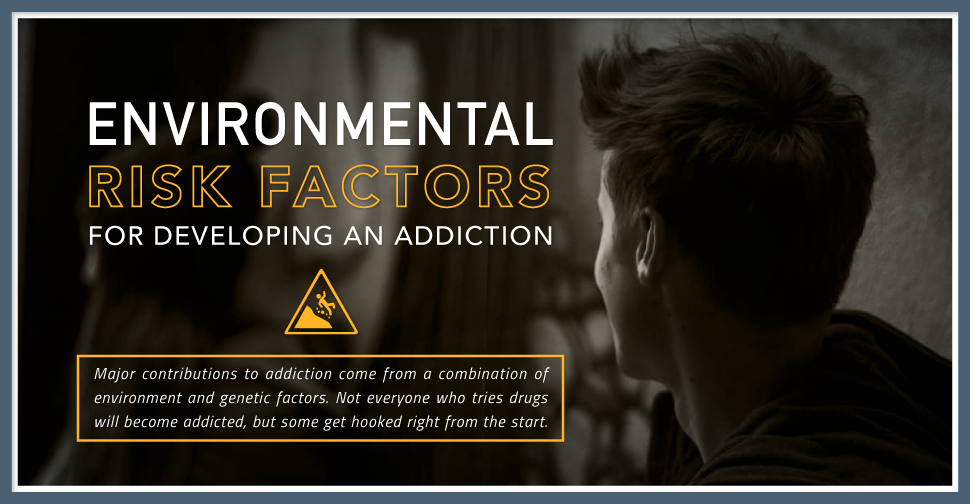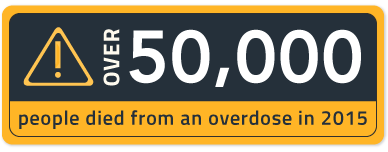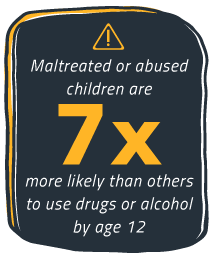
Environmental Risk Factors play a part in all of our day-to-day life. A person who goes to work as a fireman has a risk of getting burnt, much like a person who is subjected to alcohol and drugs has a risk of getting high or drunk and becoming addicted. There are a variety of environmental risk factors that play a part in developing an addiction–the more common ones are Community, Peer, Family, and School. Not everyone who tries drugs will become addicted, or even like it for that matter, but some people are hooked right from the start. It might not be too late to educate yourself, and your teens about addiction…
Have you ever known somebody since they were young, and the tragedy of addiction has always been their fate? Everyone in their life, including them, is addicted to drugs or alcohol. Their mom and dad are both addicted to drugs, their brothers are addicted to drugs; their whole family seems to be addicted to drugs or alcohol. Maybe their neighbor is even addicted to drugs. This person, like millions of others, had environmental risk factors which contributed to their own addiction.
 There are a lot of different contributing factors leading to an addiction; these can be community, family, school, and friends (peers). Though not everyone who experiments with drugs becomes addicted, approximately 10% of people who try drugs do, and major contributions to addiction come from a combination of environment and genetics. That translates to roughly one in ten people who will become addicted to a drug after trying it once.
There are a lot of different contributing factors leading to an addiction; these can be community, family, school, and friends (peers). Though not everyone who experiments with drugs becomes addicted, approximately 10% of people who try drugs do, and major contributions to addiction come from a combination of environment and genetics. That translates to roughly one in ten people who will become addicted to a drug after trying it once.
How To Identify Addiction
Addiction can be tricky to understand for someone who hasn’t experienced it first hand. It can be just as confusing, for someone who is battling addiction, to try to explain how they wasted their life savings, stole from a loved one, or went to the hospital. One of the easiest ways to understand addiction is by recognizing that the person suffering from it is very ill–both mentally and physically. They might not be able to stop using drugs or alcohol–as hard as they might try or as many times as they say they’ll quit–they’re hooked.
Are you or a loved one suffering from addiction?
Don't wait, get the best treatment options today
Call Now: (833) 473-4227Teens And Addiction
 Teens will be exposed to drugs and alcohol, whether they’re the one using them or not. If they aren’t, it will be someone they know of who is using the drug. Scientists from the National Institutes on Drug Abuse have discovered that adolescent brains are more susceptible to addiction than an adult brain, because they are not fully developed yet. They go on to say that the same teen’s still developing brain can also be more resilient to addiction, and can be taught. So there is hope…
Teens will be exposed to drugs and alcohol, whether they’re the one using them or not. If they aren’t, it will be someone they know of who is using the drug. Scientists from the National Institutes on Drug Abuse have discovered that adolescent brains are more susceptible to addiction than an adult brain, because they are not fully developed yet. They go on to say that the same teen’s still developing brain can also be more resilient to addiction, and can be taught. So there is hope…
Unfortunately, with the stigma attached to drug dependence, many families refuse to look outside the home for treatment. Most people suffering from addiction didn’t choose to become addicted to a drug–it’s just the nature of habit. Addiction can happen where we least expect it, but perhaps with the right evidence, the mind of a potential drug user will be guided elsewhere.
How Many People Are Suffering From An Addiction?
Addiction affects 23.2 million Americans, and sadly, only 10% of those people are receiving the treatment they need. With that distressing statistic, there is most likely a person in your life who is suffering from an addiction. It isn’t a disease that only affects cities, or people below the poverty line… Addiction affects everyone.
Moreover, “1 in 10 Americans over the age of 12 classified with substance abuse or dependence, addiction takes an emotional, psychological, and social toll on the country. The economic costs of substance abuse and addiction alone are estimated to exceed a half trillion dollars annually in the United States due to health care expenditures, lost productivity, and crime.” (National Institutes of Health)
What Are Some Environmental Risk Factors For Addiction?
Just about anything can play a role in a person’s addiction, but we can safely assume that each person started off experimenting with drugs that they had previously seen someone else use. A person’s first exposure to drugs and alcohol might have been brought on by a common environmental risk factor–these factors can all be better understood when put into the more specific categories:
- The Community Domain
- The Peer Domain
- The Family Domain
- The School Domain (Genetic Science Learning Center)
A person is at great risk of becoming addicted when exposed to these environmental risk factors. Though it isn’t just young adults in jeopardy; substance addiction can happen when life gets the best of you–and sometimes a person will start using a drug or alcohol to cope with loss–because it makes them feel better. This can often lead to addiction of the substance overtime. Substance use coping is dangerous and unhealthy.
Community Risk Factors For Developing An Addiction
 A person’s community can play a major role in their subjection to alcohol and drug addiction. “If a…community has favorable attitudes toward drug use, firearms and crime, their risk is increased.” (Genetic Science Learning Center) Most teens have a seemingly “cooler” neighbor whom they look up to or want to be like.. Teens are impressionable, and if they see this person they look up to smoking cigarettes, using drugs, or drinking, they might think that this is how to be cool.
A person’s community can play a major role in their subjection to alcohol and drug addiction. “If a…community has favorable attitudes toward drug use, firearms and crime, their risk is increased.” (Genetic Science Learning Center) Most teens have a seemingly “cooler” neighbor whom they look up to or want to be like.. Teens are impressionable, and if they see this person they look up to smoking cigarettes, using drugs, or drinking, they might think that this is how to be cool.
Many urban communities and neighborhoods have outreach programs and “drug-free school zones,” but sometimes communities are completely shocked to find that the drugs and alcohol are being used by their very own children–or even by people of their own stature. It can be difficult for parents, worried about addiction, to decide who to let their kids hang around with. The best method might be to educate them before the problem arises.
Peer Risk Factors For Developing An Addiction
 “The single biggest contributing factor to drug abuse risk is having friends who engage in the problem behavior.” (Genetic Science Learning Center) So how do we pick and choose friends, or try to encourage our friends not to use drugs and alcohol? Everybody is going to come across peer pressure in their life–it’s just part of being human–and it will likely always be that way.
“The single biggest contributing factor to drug abuse risk is having friends who engage in the problem behavior.” (Genetic Science Learning Center) So how do we pick and choose friends, or try to encourage our friends not to use drugs and alcohol? Everybody is going to come across peer pressure in their life–it’s just part of being human–and it will likely always be that way.
Not every misdirected kid who invites his friends to join him for a drink or a smoke is addicted to the substance, but it’s like the old saying goes “misery loves company.” By nature, prolonged use of said drug very often can lead to addiction–it’s just the way our minds work. The human brain craves euphoria, and when something feels good, tastes good, or looks good, we want more of it.
Home Risk Factors For Developing An Addiction
 An adolescent’s first exposure to drug and alcohol use often takes place in the home–this usually depends on parenting practices and general home life. These risk factors are broken down into several categories, but two common understandings of child upbringing (as related to drug and alcohol use) are maltreatment and traumatic events. Parenting practices can play a significant role in substance use disorders and addiction. Sometimes, if a mom or dad is never around to see the sometimes obvious signs of drug and alcohol use, or neglect to educate their children–those same children can be at risk.
An adolescent’s first exposure to drug and alcohol use often takes place in the home–this usually depends on parenting practices and general home life. These risk factors are broken down into several categories, but two common understandings of child upbringing (as related to drug and alcohol use) are maltreatment and traumatic events. Parenting practices can play a significant role in substance use disorders and addiction. Sometimes, if a mom or dad is never around to see the sometimes obvious signs of drug and alcohol use, or neglect to educate their children–those same children can be at risk.
Maltreatment and traumatic events can include physical abuse, sexual abuse, or simply a cruel upbringing. Maltreated or abused children are 7 times more likely than others to use drugs or alcohol by age 12. Incredibly, maltreated children, on average, are likely to use alcohol 2 years before their peers.
School Risk Factors For Developing An Addiction
 Teen may be at risk for substance use and addiction when they miss out on extracurricular activities, or or when they lack some of the social structure that comes from good grades and commitment. People strive to fit in with whomever they surround them self with, these school mates might be involved in drugs (and who knows? Maybe there is an opportunity to help them out of it.), but when such an adolescent is surrounded by others who strive to do great things, they too will seek self-improvement and success.
Teen may be at risk for substance use and addiction when they miss out on extracurricular activities, or or when they lack some of the social structure that comes from good grades and commitment. People strive to fit in with whomever they surround them self with, these school mates might be involved in drugs (and who knows? Maybe there is an opportunity to help them out of it.), but when such an adolescent is surrounded by others who strive to do great things, they too will seek self-improvement and success.
Schools offer a wonderful opportunity for teens to grow socially and mentally, but can also offer them an opportunity to grow experimentally with the exposure to drugs and alcohol. Schools can also offer information on drug and alcohol use. Drug Abuse Resistance Education (D.A.R.E.) is one example of how schools attempt to educate teens about smoking, using drugs, and drinking alcohol. Unfortunately, D.A.R.E. was claimed to be ineffective by the National Center for Biotechnology Information.
There are other classrooms which can help a person develop healthy habits: Psychology Class, Health Class, Physical Education, and Sexual Education.
How To Learn More About Environmental Risk Factors Of Addiction
Over 50,000 people died from an overdose in 2015, a number that grows leaps and bounds larger each year. If you are a parent of, spouse of, or a person suffering from an addiction–there is no reason to become another statistic. There is hope for you and your loved ones to get well, and to leave your addiction behind. If you have questions about Environmental Risk Factors for Developing an Addiction and are seeking treatment–it is not too late. Contact us today! Together, we can help make environments safer for everyone.
For More Information Related to “Environmental Risk Factors for Developing an Addiction” Be Sure To Check Out These Additional Resources From DrugRehab.org:
- Alcoholism Risk Factors
- The 45 Warning Signs Of Prescription Drug Abuse
- Talking To Your Teen About Drugs
- The Addicted Teen: Four Personality Traits Linked to Future Drug Problems, Studies Show
- Addiction Causes And Risk Factors
Sources
National Library of Medicine – The Science of Addiction: Drugs, Brains, and Behavior
Genetic Science Learning Center – Environmental Risk Factors
National Institute on Alcohol Abuse and Alcoholism (NIAAA) – Adolescents at Risk for Substance Use Disorders
National Institute on Drug Abuse – Overdose Death Rates

